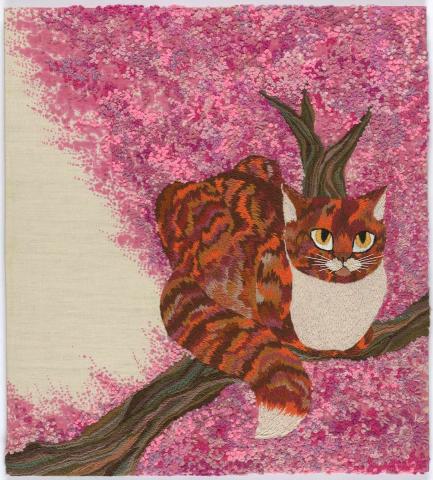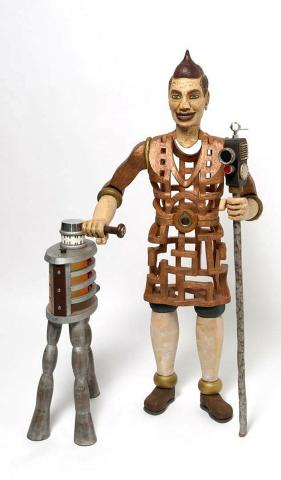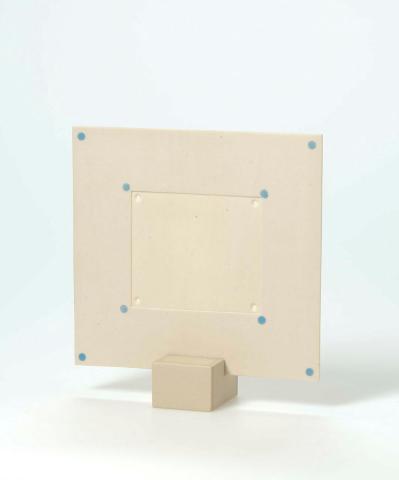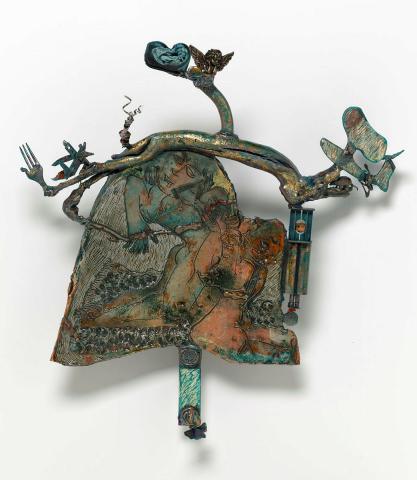Over 2021–23, the Collection Online team have photographed thousands of artworks as part of the Gallery’s Digital Transformation Initiative (DTI). This project has allowed our dedicated conservators, collection managers and photographers to delve deep into Collection storage to uncover and care for artworks not displayed in decades.
The DTI has been supported by many generous individuals through donation to our Foundation. Here, we acknowledge the hundreds of donors to QAGOMA’s ‘Unlock the Collection’ campaign, which makes our artworks more accessible and discoverable online — and in detail never seen before.
The Collection Online project allows us to share anew the Gallery’s diverse range of artworks. In ‘Small Figures’, you’ll discover some of the works we have recently prepared for photography, and some of the works that just made us smile. From small figures to tiny frogs, this Collection display represents a sample of our teams’ favourite recent finds — the weird and whimsical, the cute and curious.
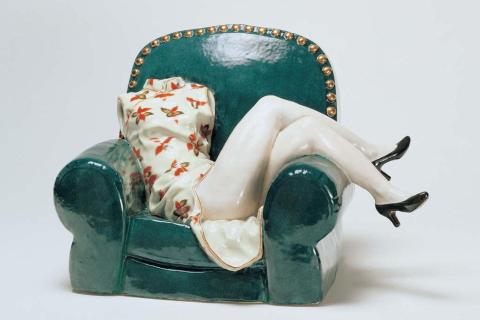
‘Small Figures’
Sep 2023 - Aug 2025
During the COVID pandemic, people the world over shared the surreal experience of lockdowns. Collection Online staff came back to the Gallery sooner than others, but long periods of being ‘housebound’ still had an effect.
Midge Johansen’s Housebound 1982 was on a list of large ceramics that needed preparation for Collection Online photography — so it was with amusement that we had this sculpture out in the Conservation lab between periods of lockdown and quarantine. The defeated look of the tortoise, who appears to carry the weight of the world, resonated with our weary team. Thus Housebound became one of our team’s favourite pieces — a mascot for this surreal period.
When preparing ceramics for photography, it’s important to clean the surface of dirt or dust; however it’s also critical to know how the artist intended the surface to look. In the case of Housebound, the dark brown and green patina is an intentional effect. Conservators also carefully checked that there were no loose parts or cracks in the very thin ceramic elements.
Not displayed for over 40 years, Inga Hunter’s Cat in a peach tree was a beautiful work to find hidden in a large crate of textiles that had been framed for a past regional tour. We were especially excited to unearth the labelled samples of dyed wools and threads, with Hunter’s own preliminary sketches and samplers. While only the tapestry itself has been accessioned, the supporting material is recognised as important to the Collection and will be retained as archival material.
Learning the types of dyes and fibres used to make a textile artwork is invaluable to conservators. This knowledge helps us best care for the work — especially when we can identify which dyes are most sensitive to fading, or which might be soluble in water or other solvents. When there is wool or silk in an artwork, measures can be taken to prevent damage by insects that might feast on these delicate fibres.

An installation view of ‘Small Figures’, featuring (l–r) work by Scott Redford and Michael Littler (© Scott Redford / Copyright Agency), Louise Weaver (© Louise Weaver), Wilma Hollist (© QAGOMA), fine porcelain wares by Meissen and unknown manufacturers, and Stephen Killick Small figure making and recording History 1991 (© Stephen Killick / Copyright Agency), QAG, September 2023 / Photo: C Callistemon, QAGOMA
When the Collection Online project began, we compiled a list of 7000 artworks that qualified for new digital photography. We grouped them by media type and size, so that similar works could be photographed efficiently. One of the groupings was ‘assemblages and installations’, where numerous components of different media must be joined together to form the complete artwork. We knew this sculpture had 11 parts and was made of wood, paint, metal and plastic — but initially had no idea what it looked like.
In the QAGOMA Library, we discovered a handwritten set of the artist’s installation notes, and then a slide showing the completed work in a 1991 exhibition. In the case of this Small figure, Stephen Killick’s instructions state that its head must be facing directly forward. Given that the head swivels on the neck, this could change the appearance of the work. Killick’s instructions also say to ‘have a cup of tea when the install process is complete’!
Killick’s original notes are now supplemented with an installation manual written by conservation staff, which includes guidelines on appropriate light levels, what tools are required, the work’s overall dimensions, how to unpack it and other display considerations. The Collection Online project has provided the opportunity to better document many of the Gallery’s complex assemblages and installations, so future staff know exactly how all the pieces fit together.
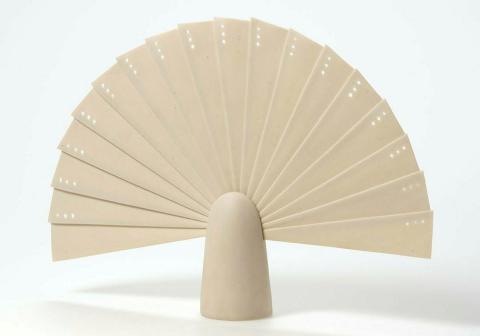
Fan 1981
- PEACH, Dianne - Creator

Coat: Celebration 1981
- HOLLIST, Wilma - Creator
Dianne Peach’s three ceramics — Fan 1981, Ornament: Triangle 1981 and Ornament: Screen with blue dots 1981 — are perhaps some of the most fragile works the Collection Online team has handled. Made of porcelain so thin it’s translucent, these works were extra challenging for Gallery staff.
To safely display them, conservators worked with specialist mount makers from the Gallery’s workshop team to design and custom-make pins to prevent the works from tipping over. When in storage, they are kept in archival boxes supported within a nest of foam, dacron and parsilk. The Collection Online team handles many hundreds of precious ceramics, and our improved storage systems mean these objects will remain available for future generations to enjoy.

An installation view of ‘Small Figures’, featuring (l–r) Joel Elenberg’s Rhinoceros head c.1977 near a vitrine displaying works by Dianne Peach and Bronwyn Kemp, QAG, September 2023 / © QAGOMA / Photo: C Callistemon, QAGOMA
When the Collection Online team first came across this sculpture by Australian artist Joel Elenberg — stored on a shelf with other bronze busts and small sculptures — it appeared to be just the bronze head of a rhinoceros. In querying the list of materials and dimensions on the Gallery’s database, it became apparent that the work was just the top of a ‘stack’ of elements carefully created by the artist. Detective work in the Library and Collection storage uncovered the original metal pedestal and block of wood, but unfortunately also confirmed that a layer of black glass had been broken sometime in the 1970s.
To respect Elenberg’s original vision for Rhinoceros head, all its parts have now been reunited and photographed as a whole — and its documentation updated. With the glass layer replaced and the bronze polished, the Collection Online team have restored the integrity of this striking sculpture.
British spinner, weaver and dyer Wilma Hollist’s Coat: Celebration has been safely kept in storage since its first appearance on display back in 1982. Created from a variety of animal fibres — including wool, silk and feathers — the coat is considered at very high risk for insect attack. Common museum pests like carpet beetles, casemaking clothes moths and cigarette beetles would all feast on the natural fibres.
While on display, the coat will be monitored regularly — and when de-installed, it will go through the Gallery’s integrated pest management program. To avoid using pesticide sprays, which might affect the artwork, the textile will be carefully frozen at −30°C for seven days. This ensures any insects, larvae or eggs that might be hidden in the fibres are rendered unviable. To protect this vulnerable artwork in the long-term, the coat is stored on a custom-made tray, sealed within high-barrier film plastic.

Rhinoceros head c.1977
- ELENBERG, Joel - Creator

Small pot c.1920s
- HARVEY, L.J. - Creator
These ceramics — some 50 displayed for ‘Small Figures’ — are just a sample of an even larger collection of miniatures made by Queensland artist LJ Harvey between the 1890s and 1940s. Harvey was a pioneer in the early days of Queensland ceramics, prolific as a maker and influential as a teacher.
Harvey’s tiny vases, pots and figurines are some our most favourite works, but also proved to be challenging. Many were stained and dirty, having been stored in family members’ collections before coming to the Gallery. Some also had small areas of damage: chips to the ceramic and glaze have been repaired with an acrylic fill, and then in-painted with watercolours and gauche to match the glaze. Any treatment undertaken by conservators is clearly documented and can be reversed using water or other solvents. If you look closely, you might see a repair to the parrot’s eyebrow and the fish’s tail. Harvey created these tiny testers to sample his glazes over the years. We're lucky to have this little abundance in such good condition.

An installation view of ‘Small Figures’, featuring (l–r) works by Warren Palmer (© Warren Palmer Estate), Liu Jianhua (© Jianhua Liu), LJ Harvey and Stephen Killick (© Stephen Killick / Copyright Agency), QAG, September 2023 / Collection: QAGOMA / Photo: C Callistemon, QAGOMA
Warren Palmer plays with an array of ideas in this mixed-media work, which proved challenging for the Gallery’s conservation team. Constructed from ceramic, coloured with glaze, paint and marker pens, and with small found metal and plastic parts attached, the work is very vulnerable to damage — and difficult to treat. Palmer has added milk bottle lids, corks, metal toys, a plastic fork and small toy animals to the work. When paints and adhesives interact with plastics and metals, it can hasten their deterioration. High resolution photography taken through the Collection Online project now allows conservators to monitor any changes in the artwork’s condition over time.
Rhiannon Walker is Associate Conservator, Collection Online at QAGOMA.
‘Small Figures’ is on in QAG's Pelican Lounge from September 2023 to August 2025. To make the most of your visit, check the exhibition dates, find out about getting here, parking and Gallery accessibility. As this is a rotating exhibition, not all works listed below will be on display simultaneously.
Digital story context and navigation
Related resources

